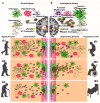Reactive Neuroblastosis in Huntington's Disease: A Putative Therapeutic Target for Striatal Regeneration in the Adult Brain
- PMID: 29593498
- PMCID: PMC5854998
- DOI: 10.3389/fncel.2018.00037
Reactive Neuroblastosis in Huntington's Disease: A Putative Therapeutic Target for Striatal Regeneration in the Adult Brain
Abstract
The cellular and molecular mechanisms underlying the reciprocal relationship between adult neurogenesis, cognitive and motor functions have been an important focus of investigation in the establishment of effective neural replacement therapies for neurodegenerative disorders. While neuronal loss, reactive gliosis and defects in the self-repair capacity have extensively been characterized in neurodegenerative disorders, the transient excess production of neuroblasts detected in the adult striatum of animal models of Huntington's disease (HD) and in post-mortem brain of HD patients, has only marginally been addressed. This abnormal cellular response in the striatum appears to originate from the selective proliferation and ectopic migration of neuroblasts derived from the subventricular zone (SVZ). Based on and in line with the term "reactive astrogliosis", we propose to name the observed cellular event "reactive neuroblastosis". Although, the functional relevance of reactive neuroblastosis is unknown, we speculate that this process may provide support for the tissue regeneration in compensating the structural and physiological functions of the striatum in lieu of aging or of the neurodegenerative process. Thus, in this review article, we comprehend different possibilities for the regulation of striatal neurogenesis, neuroblastosis and their functional relevance in the context of HD.
Keywords: Huntington’s disease; adult neurogenesis; doublecortin; reactive neuroblastosis; striatum.
Figures

Similar articles
-
Cell cycle re-entry of neurons and reactive neuroblastosis in Huntington's disease: Possibilities for neural-glial transition in the brain.Life Sci. 2020 Dec 15;263:118569. doi: 10.1016/j.lfs.2020.118569. Epub 2020 Oct 10. Life Sci. 2020. PMID: 33049278 Review.
-
Neurogenesis in the striatum of the quinolinic acid lesion model of Huntington's disease.Neuroscience. 2004;127(2):319-32. doi: 10.1016/j.neuroscience.2004.04.061. Neuroscience. 2004. PMID: 15262322
-
Reduction in subventricular zone-derived olfactory bulb neurogenesis in a rat model of Huntington's disease is accompanied by striatal invasion of neuroblasts.PLoS One. 2015 Feb 26;10(2):e0116069. doi: 10.1371/journal.pone.0116069. eCollection 2015. PLoS One. 2015. PMID: 25719447 Free PMC article.
-
Aberrant Hippocampal Neuroregenerative Plasticity in Schizophrenia: Reactive Neuroblastosis as a Possible Pathocellular Mechanism of Hallucination.Neurosignals. 2024 Jul 4;31(1):1-25. doi: 10.33594/000000712. Neurosignals. 2024. PMID: 38967556 Review.
-
Neuroplasticity, limbic neuroblastosis and neuro-regenerative disorders.Neural Regen Res. 2018 Aug;13(8):1322-1326. doi: 10.4103/1673-5374.235214. Neural Regen Res. 2018. PMID: 30106033 Free PMC article. Review.
Cited by
-
Resveratrol Mediated Regulation of Hippocampal Neuroregenerative Plasticity via SIRT1 Pathway in Synergy with Wnt Signaling: Neurotherapeutic Implications to Mitigate Memory Loss in Alzheimer's Disease.J Alzheimers Dis. 2023;94(s1):S125-S140. doi: 10.3233/JAD-220559. J Alzheimers Dis. 2023. PMID: 36463442 Free PMC article. Review.
-
TGF-β Signaling: A Therapeutic Target to Reinstate Regenerative Plasticity in Vascular Dementia?Aging Dis. 2020 Jul 23;11(4):828-850. doi: 10.14336/AD.2020.0222. eCollection 2020 Jul. Aging Dis. 2020. PMID: 32765949 Free PMC article. Review.
-
The caudate nucleus undergoes dramatic and unique transcriptional changes in human prodromal Huntington's disease brain.BMC Med Genomics. 2019 Oct 16;12(1):137. doi: 10.1186/s12920-019-0581-9. BMC Med Genomics. 2019. PMID: 31619230 Free PMC article.
-
Non-Cell Autonomous and Epigenetic Mechanisms of Huntington's Disease.Int J Mol Sci. 2021 Nov 19;22(22):12499. doi: 10.3390/ijms222212499. Int J Mol Sci. 2021. PMID: 34830381 Free PMC article. Review.
-
Migratory Response of Cells in Neurogenic Niches to Neuronal Death: The Onset of Harmonic Repair?Int J Mol Sci. 2023 Apr 1;24(7):6587. doi: 10.3390/ijms24076587. Int J Mol Sci. 2023. PMID: 37047560 Free PMC article. Review.
References
LinkOut - more resources
Full Text Sources
Other Literature Sources

